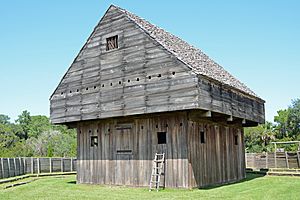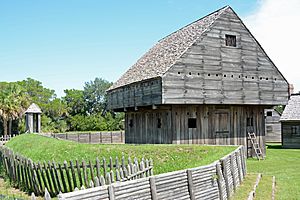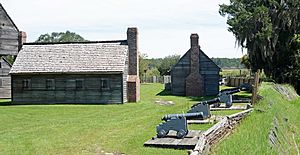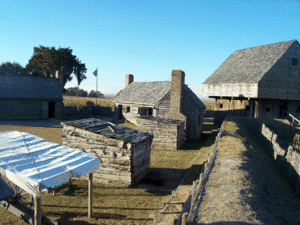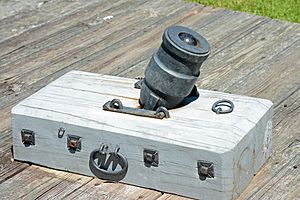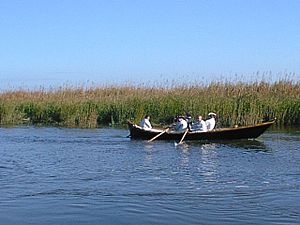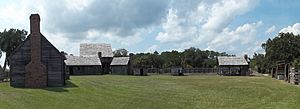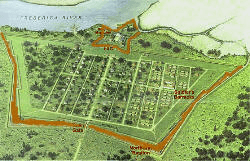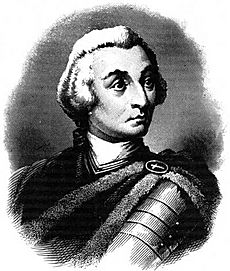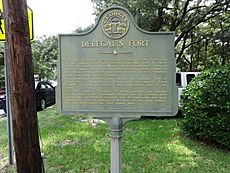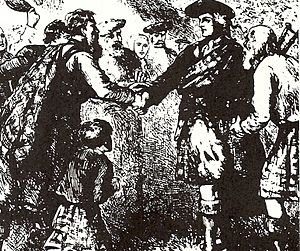Fort King George facts for kids
Quick facts for kids |
|
|
Fort King George State Historic Site
|
|

Main façade of the reconstructed fort
|
|
| Location | McIntosh County, Georgia |
|---|---|
| Nearest city | Darien, Georgia |
| Area | 12 acres (4.9 ha) |
| Built | 1721 |
| Architect | Colonel John "Tuscarora Jack" Barnwell |
| Architectural style | Earthen palisade |
| NRHP reference No. | 71001101 |
| Added to NRHP | December 9, 1971 |
Fort King George State Historic Site is a historic fort located in McIntosh County, Georgia, right next to the town of Darien. Built in 1721 along the Darien River, it was the southernmost outpost of the British Empire in North America until 1727. This fort was a key part of Britain's plan to protect its land and encourage more people to settle in the area.
Life at Fort King George was very tough for the soldiers. Many of them got sick and died from diseases like dysentery and malaria, not from battles. These soldiers were part of a special group called The Independent Company of South Carolina. They faced many challenges, including poor health, not enough supplies, and difficult living conditions.
Even though the fort was abandoned, it became a model for General James Oglethorpe when he later founded the colony of Georgia. In 1736, Scottish colonists settled the same spot where the fort once stood, calling their village New Inverness, which later became Darien. Today, Fort King George has been rebuilt and is open to the public. You can visit and explore the blockhouse, officers' quarters, barracks, and a museum that tells the story of the area's history.
Contents
Why the Fort Was Built
For almost 200 years before Georgia was founded in 1733, European countries fought to control this part of North America. The area had many rivers, like the Altamaha, Ogeechee, and Savannah, which were important for trade and travel. Native American tribes also lived here. The coastline had many barrier islands and rivers, making it a natural defense.
The Fight for Control in the Southeast
Spain, France, and Great Britain all wanted to control this valuable land. Spain had founded St. Augustine, Florida in 1565 to protect its treasure ships. France expanded its fur trade in the South. The British wanted to protect their southern borders, especially near the Savannah River. This competition greatly affected the Native American peoples, changing their traditional ways of life.
The British built Fort King George in the 1720s to help settle the Altamaha River region. They needed to control the rivers for trade, especially the fur trade with powerful tribes like the Creek/Muskogee. The Altamaha River was a major route into the territory.
Spain's Early Presence
The Spanish were the first Europeans to arrive in the Southeast. They built missions to convert Native American tribes and use them for farming. These missions, along with military posts called presidios, helped the Spanish control the coastline. One important mission, Santo Domingo de Talaje, was located on a bluff up the Altamaha River. This is the same spot where Fort King George was later built.
However, English colonists from Charlestown (in Carolina) began attacking and destroying the Spanish missions in the late 1600s. This pushed the Spanish out of the modern Georgia coast and increased tensions between Spain and England.
French and British Rivalry
Further west, the French were moving down the Mississippi River and into the Gulf region. They built Fort Toulouse in 1718 to trade with the Creek people, which worried the British. The British saw this as a threat to their own trade networks.
In 1702, Spain and France allied against Great Britain. South Carolina felt threatened by enemies on its borders. The Yamasee War (1715–1717) further weakened South Carolina. This war started because Carolina traders had been unfair to Native Americans. After the war, South Carolina was left vulnerable, and the Spanish tried to encourage enslaved people to run away to St. Augustine.
The colonists in South Carolina were unhappy with their leaders in England, called "Proprietors," who weren't doing enough to protect them. In 1719, they rebelled and asked the British Parliament to make South Carolina a royal colony. This change was approved in 1720, with the hope that the Crown would provide better defense.
Colonel Barnwell's Plan
Colonel John "Tuscarora Jack" Barnwell, a skilled leader, proposed a plan to build a series of forts along South Carolina's borders. These forts would protect against French and Spanish expansion and encourage new settlements. He convinced the British Board of Trade to approve building a fort on the Altamaha River to stop French advances.
Barnwell wanted strong, young soldiers for the fort, but due to financial problems in Britain, they sent older, less healthy soldiers. This group, called His Majesty's Independent Company of Foot of South Carolina, faced many hardships. Most of the soldiers and officers, including Barnwell, died at the fort by 1727. Despite its short life, Fort King George was important because it showed the British how difficult it was to control the Southeast and led to future plans for the region.
Building and Abandoning the Fort

Life at Fort King George was full of challenges from 1721 to 1727. The soldiers who sailed from London in 1720 hoped for a new life with land and resources. However, they all got scurvy on the voyage. When they arrived in South Carolina, they had to recover in a hospital for months.
Construction Challenges
With his soldiers sick, Colonel Barnwell had to hire "Coastal Scouts" and civilians to build the fort. These scouts were tough seamen, some possibly former pirates, who were known for being difficult to manage. Barnwell often complained about their behavior and lack of discipline.
Despite these problems, the fort's main blockhouse was finished by the fall of 1721. The men had to cut large cypress trees from miles upriver. Barnwell even had to offer extra pay and rum to motivate them. He also explored the coast and suggested moving the fort to St. Simons Island, but his idea was rejected due to costs.
Life and Death at the Fort
By early 1722, the Independent Company was stationed at Fort King George. Within a year, almost half of them had died, mostly from diseases like dysentery and malaria. The soldiers struggled with motivation, often neglecting their duties to build farms or fences. Some even ran away to St. Augustine. The fort's guardhouse became known as a hospital for the sick.
In 1722, there were reports of 170 Yamasee Indians planning to attack the fort, possibly encouraged by the Spanish. It's unclear if the attack happened, but the fort must have survived if it did. Later that year, Swiss soldiers who had deserted a French settlement arrived at the fort seeking safety. One of them drew a detailed plan of the fort, showing it as a triangular structure with a barracks, guardhouse, and officers' quarters.
Spanish Protests and the Fort's End
The Spanish constantly protested the British presence on the Altamaha. In 1724, Spanish representatives came to complain, but they were not allowed inside the fort to prevent them from seeing its defenses. The diplomatic arguments continued for years.
More drawings from 1726 show the fort had strong defenses, including a parapet (a protective wall), a palisade fence, and a moat. It also had nine cannons facing the river. The fort was built on a bend in the river, making it hard for enemy ships to attack. These forts were usually temporary, made from local wood and earth, and easy to repair.
Colonel Barnwell died in 1724, likely due to his difficult time at the fort. His ideas, however, later influenced General Oglethorpe. In late 1725 or early 1726, the fort mysteriously burned down. Some believed the soldiers might have caused it or didn't try hard to put out the fire, hoping to escape their miserable lives there. But their wish didn't come true; the fort was rebuilt.
Finally, in 1727, the British Parliament ordered Fort King George to be abandoned. The soldiers were moved to Port Royal, South Carolina. In total, 140 soldiers and officers died at the fort, mostly from disease. The fort's location was unhealthy and ineffective. The abandonment caused concern among South Carolina colonists.
Despite its failure, Fort King George taught important lessons. It showed that settlers in this harsh environment needed to be young, strong, and self-reliant. It also shifted Britain's focus to defending the southern coast with forts and settlements on the barrier islands. This knowledge helped General Oglethorpe plan a more successful defense system for Georgia, including Fort Frederica on St. Simons Island.
Fort King George's Impact on Georgia
The struggles at Fort King George directly influenced the founding of Georgia. During the 1720s, a Swiss man named Jean-Pierre de Pury suggested a colony called Georgia between the Savannah and Altamaha Rivers. This idea, though Pury's plan failed, drew attention to the area.
General Oglethorpe's Vision
At the same time, General James Oglethorpe was working to improve prison conditions in England. He also wanted to defend Britain's lands in North America. These two goals led to the idea of Georgia: a place where poor people could start new lives and also serve as "citizen-soldiers" to protect the empire.
The first colonists for Georgia were mostly middle-class artisans and craftsmen, not debtors. They were meant to defend the colony and help its economy by producing crops, timber, and furs. Oglethorpe learned from the mistakes at Fort King George. He knew he needed strong, resilient people to settle the Altamaha area.
The Scottish Highlanders of Darien
Oglethorpe understood the unique geography of the Georgia coast, with its vast marshlands and strong tides. He decided to use the barrier islands for defense. He placed Fort Frederica on St. Simons Island and other forts nearby to protect the Altamaha River system. Controlling the river was key to controlling the surrounding land and trade routes.
Oglethorpe knew that Scottish Highlanders were tough and skilled fighters. In 1735, he sent recruiters to Scotland to find settlers for Georgia's Altamaha frontier. Many Scots were eager to come, seeking new opportunities away from hardship in their homeland. They were offered land, weapons, cattle, and farming tools.
In November 1735, 177 Scots sailed to Georgia. They arrived in January 1736 and soon settled near the old Fort King George site, calling their town Darien. This name honored an earlier Scottish settlement attempt in Panama. Oglethorpe visited them, showing his respect by wearing a traditional Scottish kilt. He also decided to move their town slightly upriver, likely remembering the flooding and health problems at the old fort site.
Darien's Success and Legacy
By the end of 1736, Darien was thriving. The Scots became vital settlers for Georgia. They helped establish a timber industry, sending lumber down the Altamaha River to sawmills in Darien. They also improved trade with the Creek Native Americans.
Their most important role was military. When the Spanish invaded Georgia in July 1742, the Scots of Darien were crucial in defeating them at the Battle of Bloody Marsh on St. Simons Island. This victory helped secure Britain's control over the area.
Fort King George, despite its failure, provided a blueprint for Georgia's successful defense and economy. It taught future leaders that strong, dedicated settlers were needed. The idea of "citizen-soldiers" who would both defend and develop the colony proved successful. The town of Darien and its timber industry also began at the site of Fort King George. It's interesting to think that the fort's failure ultimately helped Georgia succeed.
Developing Fort King George State Historic Site
For almost 200 years after it was abandoned, Fort King George was largely forgotten. It was sometimes mentioned as "Barnwell's Bluff" or "Old Fort." In the early 1900s, historians began researching Georgia's early history, bringing the fort's story back to light.
Rediscovery and Reconstruction
In the 1930s, local historian Bessie Lewis, a history teacher from Darien, studied old British records. She found detailed information, drawings, and descriptions of Fort King George. Her research helped locate the original site. Later archaeological digs confirmed her findings, even uncovering soldiers' graves.
Miss Bessie and other locals formed the Fort King George Association. They worked to have the site developed as a state historic site. In 1949, the state bought the land. While a monument and picnic tables were added in the 1950s, the dream of a reconstructed fort took longer.
In the late 1960s, the Georgia Historical Commission took over the site. Money was approved for a museum in 1967, and Fort King George Historic Site officially opened. In 1972, the Georgia Department of Natural Resources began managing it. In 1987, efforts to rebuild the fort's blockhouse began, and it was dedicated in 1988.
From 1999 to 2002, Georgia State Senator Renee Kemp helped secure funding to reconstruct the soldiers' barracks, guardhouse, and officers' quarters. Site staff also rebuilt the firing walls and steps. By 2004, with the addition of the fort's gates, Fort King George was fully reconstructed, fulfilling Miss Bessie's dream.
Today, Fort King George Historic Site is a popular tourist attraction, welcoming over 30,000 visitors each year. Staff offer many living history programs that teach about Colonial life and military history.
See also




